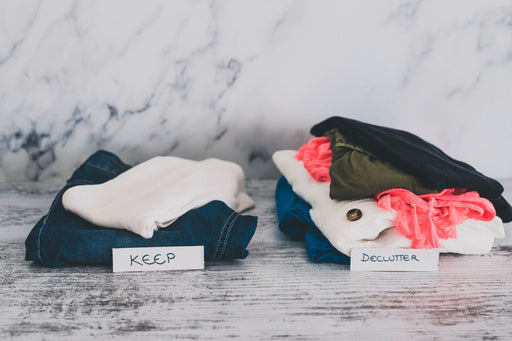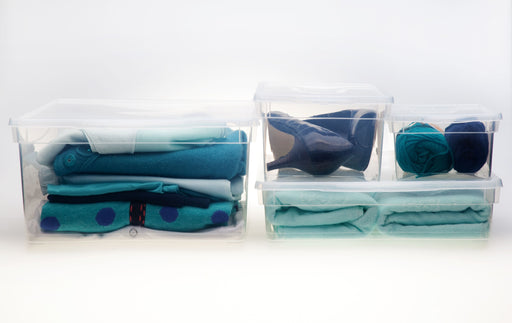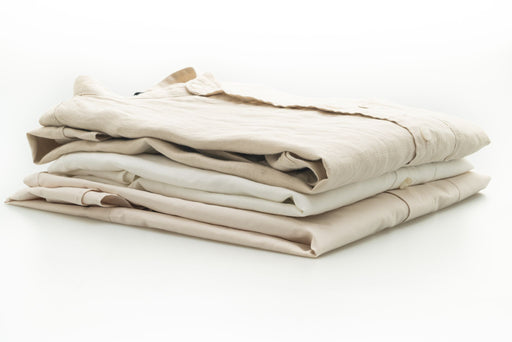Top Seasonal Clothes Storage Solutions

Ah, it's that time of year again! Time to transition from one season to another. Whether the temperatures are getting warmer and birds are starting to chirp or things are starting to cool down and transition into fall and winter, season changes can be exciting.
The change in weather means plenty of new exciting seasonal hobbies and activities, special occasions to look forward to, and, of course, pulling out some of your favorite clothes for the season! This also means you’ll need to prepare your current wardrobe for seasonal storage. Now, you’re probably starting to worry about all the time and energy it is going to take to get your clothes stored. However, seasonal clothing storage doesn’t have to be difficult, though. Use these top tips for how to store out of season clothes to help you get your current wardrobe organized and put away until you’re ready for it next year!
Thin Down Your Wardrobe
Before you begin thinking about season clothes storage ideas, it is a good idea to thin down your wardrobe and get rid of anything you’re unlikely to use again. Take some time to sort through all of your items and look for anything that is damaged, out of style, uncomfortable, or just something you don’t enjoy wearing any more.
Make a keep pile and sort the unwanted clothes into those that may be worth selling, items that should be donated, and clothes that are in such poor shape that can go to recycling. When you take the time to go through your clothes, you’ll be amazed by how much you’re able to get rid of, especially if it's been a long time since you’ve cleaned out your wardrobe. Not only will this mean less clothing that will need to be stored, it will leave you with a wardrobe you’re happy with for the start of the next season.

Clean and Freshen Up Items
Now, before you just take that ‘keep’ pile and start folding it for storage, you’ll want to make sure everything is freshly cleaned. If you have clothes that haven’t been washed recently or that you may have worn once and hung back up, it is imperative that you wash them before packing them away for storage. Any odors, dirt, or debris that aren’t cleaned up before storage may face irreversible staining and will attract pests.
If you notice any stains on your clothing items, now is also the best time to treat them. If you don’t try to remove the stains now, they’ll be much more difficult to remove in the future and may damage the fabric.
Now that your clothes are clean, make sure they are entirely dry. If there is any hint of moisture, it could create a good environment for mold or mildew to grow, which is the last thing you want all over your seasonal clothes!
Sort and Organize
Don’t reach for those boxes just yet!
First, take some time to sort and organize your clothes. Trust us; your future self will thank you for getting everything organized since it will be much easier to refill your closets and drawers with it next season. Plus, you’ll be able to take stock of what you have after downsizing your wardrobe. For example, if somehow you’re only left with one or two pairs of shorts, you can make a mental note to buy some at the beginning of the next season or be on the lookout for clearance sales.

Also, as you’re organizing your clothing, think about the climate in the area where you live. Even though the season is changing, are there likely to be any abnormally hot or cold days when you may want to have some off-season clothing easily accessible? If so, save a few outfits for this purpose.
Prepare and Pack Clothing for Storage
Now you should have clean clothes that are sorted and ready for storage. Even if you have the space in your closet, you won’t want to leave everything hanging in the back of your closet until next season. This can stretch out shirts and sweaters and doesn’t offer optimal conditions for long-term clothing storage.
Rather, you will want to store most of your seasonal wardrobe in storage containers. Plastic bins or archival storage boxes are the two options you should consider. These boxes are made from acid-free materials to protect your items and keep them from yellowing. In addition, these boxes are sturdy and should give you the reassurance that they will keep pests out.
Plastic bins can be another great choice. They are even sturdier if you’re worried about stacking boxes together. Choose bins that offer tight-sealing lids to ensure clothes moths and other pests won’t be able to get at your clothing items. You can add acid-free paper between the layers in the box to help prevent the inevitable yellowing that will occur over long periods of time.
Read more on our blog for tips on how to preserve your favorite clothes to make them last.

While it may be tempting to use plastic bags or cardboard boxes, these are not good long-term storage containers. Cardboard boxes are much more likely to attract moths and other bugs. They also aren’t as resistant to moisture or humidity as plastic bins are. Plastic bags (or plastic dry cleaning bags) also aren’t good for storing clothes, since they aren’t breathable and can trap moisture in with your garments.
Before packing your items in a plastic bin or archival storage box, fold each item, but take care not to press down the creases too much. You also won’t want to overstuff the bins, since it can make the creases more pronounced and more difficult to remove next season.
Before closing up each bin or box, add some cedar blocks or lavender sachets. These will help protect your items from clothes moths. However, keep in mind that overtime cedar blocks and lavender sachets can lose their effectiveness, so you may either need to renew or replace them.
Here’s where you’ll be glad you spent a little time organizing your clothes and grouping like items together: after each box is packed, label it so you’ll be able to easily find what you need next season.

Select the Ideal Storage Location
If you don’t choose the right location to store your clothes, all of the effort you’re putting into sorting and organizing your clothes could be for naught. When clothes aren’t stored in a suitable location, they may become moldy, attract moths or insects, fade, or become otherwise damaged.
The best location to store your precious items should be dry, dark, and cool. These conditions will offer the greatest protection for storing out of season clothes.
Basements are popular storage areas, but they are often not the best choice. They are more likely to be humid, which can result in the growth of mold or mildew. Attics are another place many individuals consider. However, they are often too warm, which can also damage fabrics.
If you have a small available closet, you can read about storage ideas for cramped spaces in order to store clothing there.
If after surveying your home, you discover that you don’t really have a great spot to store your seasonal clothing, you may want to consider renting a climate controlled storage unit. This can give you peace of mind that your items are being stored in the optimal conditions to keep them preserved and ready for next season. Your investment in the storage unit will surely pay off since you’ll be able to use it again for next season.
Whichever storage location you decide on, be sure to give it a good cleaning before loading up your storage containers. This will help ensure that your items stay clean, fresh, and ready to wear again soon.
Periodically Monitor Storage Conditions and Clothing
Finally, check-in on your stored seasonal clothes periodically. Inspect the storage bins to make sure they are not damaged, are properly sealed, and are doing their job to protect your clothes. If you see any cracks or other damage, find a replacement container as soon as possible.

Storing seasonal clothes properly is essential. If you don’t take the time to prepare your seasonal wardrobe for storage, pack it up correctly, and choose an appropriate storage location, you’re risking ruining some of your items, or even your entire wardrobe! And, we know you definitely don’t want that! Hopefully, you’ll be able to use our tips to store your seasonal clothes in the best way possible so they’re ready and waiting for you to rediscover them next season!
Seasonal Clothing Storage Frequently Asked Questions
Should I store seasonal clothes?
Yes, seasonal clothes should be properly stored and not simply left hanging in a closet. Hanging clothes, especially t-shirts and sweaters, can cause them to stretch out and damage the fabric.
What is the best way to store seasonal clothing?
Seasonal clothing should be stored in a dry, cool, and dark space. Assess the suitability of different rooms in your home, and if you don’t have any spaces that meet these criteria, consider renting a climate-controlled storage unit. This will help ensure that no moisture reaches your clothes, which can lead to the growth of mold or mildew.
About MothPrevention
MothPrevention® speak to customers every day about their clothes moth issues - clothes moths are a species that are ever increasing and that can cause significant damage to clothes, carpets and other home textiles.
To date, we’ve helped over 250,000 customers deal with their moth problems. We have developed professional grade solutions including proprietary pheromones and trap design, not available from anybody else in the USA.





